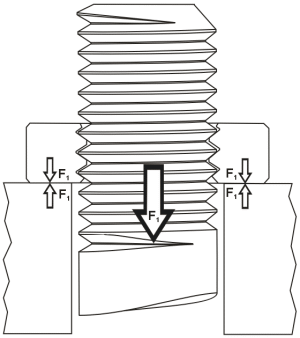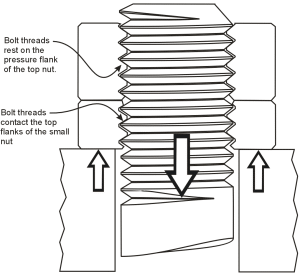
 Many types of old machinery have two nuts on the bolts. A thin
nut is frequently used in these applications. Sometimes the
thin nut can be observed below the standard thickness nut and
on other installations, it’s on top. Although it may seem
counter-intuitive, the thin nut should go next to the joint
and not be put on last. In other applications, for example on
column attachments, two standard thickness nuts are frequently
used.
Many types of old machinery have two nuts on the bolts. A thin
nut is frequently used in these applications. Sometimes the
thin nut can be observed below the standard thickness nut and
on other installations, it’s on top. Although it may seem
counter-intuitive, the thin nut should go next to the joint
and not be put on last. In other applications, for example on
column attachments, two standard thickness nuts are frequently
used.
In this article the effectiveness of this locking method
is investigated and the tightening procedure that should be
used if effective locking is to be achieved.
The use of two plain nuts goes back at least 150 years based
upon observation of historic machinery. Tightening one nut
down and then simply tightening another nut on top of it achieves
little locking effect. A specific procedure needs to be followed
if locking is to be achieved. When a thin and thick nut are
used, it may be thought that the thick nut should go next
to the joint since this would take the entire load. However,
by placing the thin nut on first, when the thick nut is tightened
on top of it, the load on the threads of the thin nut are
relieved of their load.

The thin nut should be placed on the bolt first. This nut
is typically tightened to between 25% to 50% of the overall
tightening torque. The second (thick) nut is then placed on
the bolt and the thin nut held to prevent rotation by a spanner
whilst the thick nut is tightened to the full torque value.
The series of diagrams show the effect that the procedure
has on forces present between the nuts and in the bolt.
When the thick nut is tightened onto the thin nut, as the
load increases, the load is lifted from the pressure flanks
of the thin nut. As tightening continues a point is reached
when the bolt thread touches the top flanks of the thin nut.
At this point F3 = F2. Continuing to tighten the top nut results
in the jamming of the threads leading to F3 > F2. If tightening
is continued, the force between the two nuts will continue
to increase. If the thick nut is overtightened, there is the
risk of thread stripping or the tensile fracture of the bolt
between the two nuts.

The reason why the two nut system is effective in resisting
self loosening is due to the way the threads are jammed together
(hence the term jam nut being frequently used for the thin
nut). Since the bolt thread is in contact with the top flank
of the small nut and the bottom flank of the top nut, relative
thread movement is not possible. For self-loosening to occur,
relative movement between the bolt and nut threads must occur.
It is this jamming action that is the secret of the two-nut
method.

In order to achieve the appropriate bolt preload prior to
the threads jamming it is necessary to tighten the smaller
nut. The greater the grip length of the joint, the greater
is the extension needed to achieve a given preload and hence
the higher the initial load that must be sustained by the
small nut. Although the axial backlash can be calculated for
given tolerance conditions of the nut and bolt threads, there
can be a factor of 10 difference between the minimum and maximum
values. Such variation makes it difficult to establish the
correct preloading of the small nut. As a result, the bottom
nut is tightened to a simple percentage (i.e. 25% to 50% of
the overall torque value). Two full height nuts can be used
if the principles that have been outlined above are followed.
Small (jam nuts) are frequently used since there is no need
to have a full height nut on the bottom since the threads
do not carry the load. An advantage of a thin nut in this
application is that a greater amount of axial backlash will
be provided for a given tolerance class.
On occasions, two thin, or jam nuts used together can be observed, one placed on top of the other.
If the nuts are tightened to any extent, this is a poor and undesireable practice. It may be believed that the strength of two thin nuts used in this way is greater than that of a single normal nut. This is true if the two thin nuts are on top of each other and a proof load test is completed on both simultaneously, but not true if the nuts are tightened, which is the norm. What can happen is that when the first nut is tightened, some partial thread stripping can occur, often of the bolt due to the small length of engagement that the thin nut provides. This may not be readily detectable at the time of assembly. The second nut is then tightened on top of the first. Because of the partial stripping that's occurred, plastic deformation in the threads occurs after the tightening is completed. This results in a loss of preload and the joint potentially coming loose. If two nuts are desired to be used, for whatever reason, use of two normal height nuts would avoid the thread stripping issue.
The two videos shown below presents the results of a Junker
fastener vibration test performed on the two arrangements
that a thick and thin nut on can be arranged. The tests were
conducted to investigate the effectiveness of the two-nut
method in terms of resistance to self-loosening. A Junker
transverse vibration test machine was used with M10 nuts and
bolts. The results are illustrated in the graph below. With
the small nut on top, both nuts can be observed to rotate
together and can subsequently come completely loose. The results
are slightly better than is normally observed with a single
plain nut. With the small nut next to the joint, some relaxation
occurs but not a significant amount of self-loosening . The
performance of the two-nut method, when properly applied,
provides a superior locking capability when compared to many
so-called lock nuts. The proper application of the two-nut
method is time intensive and requires a degree of skill and
is hence unlikely to make a major comeback on new machinery
any time soon.
The first video shows a test in which the normal height nut is tightened onto the joint first followed by the thin nut being tightened on top.
In this second test shown below, the thin nut was placed next to the joint and the normal height nut tightened on top.
